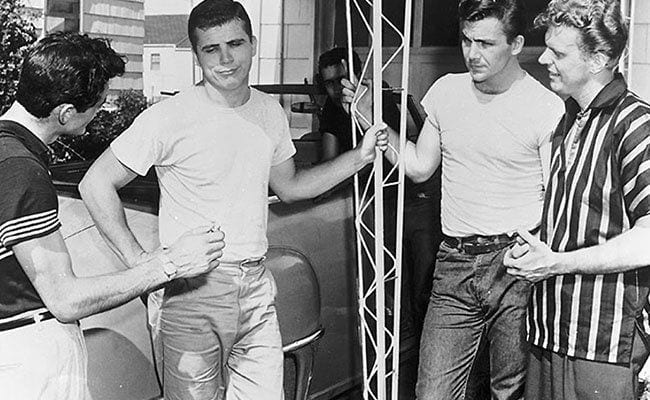
“Here is the screen’s most shocking exposé of the baby faces who have just taken their first stumbling steps down Sin Street USA. Here is a picture that dares to put on film the ravaged lives of the adolescent jungles of America today. Here is the social register of the shiv, the zipgun and the back alley emotion. These are the children of violence who live today as if there’s no tomorrow. These are The Delinquents.”
And this is the world of the exploitation film aimed at those alleged deliquent audiences that wanted to get out of their parents’ houses and away from the TV. They’d head to the drive-in for films made especially for them, often produced independently. The juvie movies titillated them with the mischief they were supposed to be committing while moralistic endings and heavy-handed narration made it all sound important and relevant.
The rash of “juvenile delinquency” movies, which pandered to and deplored the new teen market, were a code for “suburban middle-class white kids gone wrong”. It all starts with playing pool and saying “swell” and reading Captain Billy’s Whiz-Bang, so we know it’s a longtime problem. The trailer quoted above also blazes such messages as “One thing leads to another” and “They have to hurt someone even if it has to be themselves!” before promising “It will shock you to the core!” Promising more than it can deliver, thanks to censorship standards, is par for the exploitation course.
This particular example is unimpressive as typical of the genre’s mixed messages, pitting misguided and/or malevolent “teens” (played by actors in their 20s) against uptight parental squares who just don’t understand. The general inspiration is Romeo and Juliet by way of Rebel Without a Cause (1955), Hollywood’s most polished mainstream example of the trend, and all such movies tend to dwell in its shadow.
Nevertheless, The Delinquents is important and intriguing for other reasons. Shot in Kansas City, Missouri, it’s an early example of a locally produced indie that made a tidy sum for the distributor that picked it up, United Artists. Most importantly, it’s the feature debut of two talents, star Tom Laughlin and writer-producer-director Robert Altman.
Laughlin, later famous as Billy Jack in a series of ’70s action movies, is in full broody James Dean mode as Scotty White, the would-be “good kid” (and literal White kid) and alleged teen whose “going steady” with almost-17-year-old Janice (Rosemary Howard) alarms the latter’s parents. As they explain it, the problem is that they want her to go out with a bunch of different boys every night because she’s too young to be “serious”! Janice’s mom is played by Altman’s then-wife Lotus Corelli, while their little daughter Christine plays Scotty’s sister.
This implied sexual frustration created by the older generation promptly gets Scotty mixed up with “the wrong crowd” led by charming psychotic Bill Cholly, played by Peter Miller, who had uncredited punk roles in the seminal 1955 items Blackboard Jungle and Rebel Without a Cause. Bill’s special buddy is loud short-tempered Eddy (Richard Bakalyan, also in many delinquent roles), who bristles like a yanked dog when Bill gets friendly with Scotty.
In a world where knives are flashed, it’s only a matter of time before somebody gets penetrated, and the only question is who by whom. Bill starts playing go-between for the young couple and inviting them to wild parties full of drinking and necking, which they quickly decide isn’t their scene but a bunch of stuff happens before it all comes out in the wash and the stentorian narrator returns to wag his metaphorical finger at a presumably enlightened and chastened audience.
Altman had been making local industrial and educational films for years when he was hired by producer and entrepreneur Elmer Rhoden Jr., who owned a theater chain, to make a teen drama for a modest sum. He used mostly local actors and techs he’d worked with before, including his sister Joan, while the three “juvenile” males were scouted from a trip to Hollywood.
There’s not a trace of the free-form stylistic devices for which Altman became famous, as he was making a strictly commercial drive-in project to order. However, he made it with a free hand, a good black and white photographer in Charles Paddock (whose work shows well on this HD remastering), and even the cooperation of local police, who are duly thanked in the credits. The narration was added by United Artists to make sure things were kosher.
So the film comes across as a mix of mainstream professional craft, local amateur actors, and good location work all over Kansas City. Altman’s interests are signaled in the opening scene where African American singer Julia Lee and the Bill Nolan Quartet perform at a local nightclub Altman patronised, and here we see the germ of his 1996 film, Kansas City, and his tendency to include musical performances in his dramas. Another fun note: when the kids go to the drive-in, the films showing are Desperate Hours (1955) and How to Marry a Millionaire (1953).
Socially, this phase of the delinquency issue was running its course, as evidenced by the same year’s release of Jerry Lewis in The Delicate Delinquent, co-starring Bakalyan. Entering the ’60s and the release of Psycho, the violence in exploitation films would become harsher and more psychopathic.
You wouldn’t necessarily have predicted it from this project, but Altman’s next move was directly to Hollywood, where he landed in TV with Alfred Hitchcock Presents and good work in several series before re-launching a feature career ten years later.
As mastered for Blu-ray, this inauspicious low-budget debut in American cinema looks excellent. There are no extras besides the trailer.


![Call for Papers: All Things Reconsidered [MUSIC] May-August 2024](https://www.popmatters.com/wp-content/uploads/2024/04/all-things-reconsidered-call-music-may-2024-720x380.jpg)



